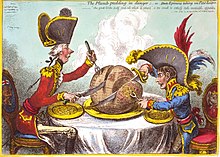
Back كرتون سياسي Arabic Vinyeta de premsa Catalan Cartŵn gwleidyddol Welsh Caricatura editorial Spanish کارتون مطبوعاتی Persian Dessin de presse French Charge Galician איור עיתונות HE राजनीतिक कार्टून Hindi Kartun editorial ID

A political cartoon, also known as an editorial cartoon, is a cartoon graphic with caricatures of public figures, expressing the artist's opinion. An artist who writes and draws such images is known as an editorial cartoonist. They typically combine artistic skill, hyperbole and satire in order to either question authority or draw attention to corruption, political violence and other social ills.[2][3]
Developed in England in the latter part of the 18th century, the political cartoon was pioneered by James Gillray,[4] although his and others in the flourishing English industry were sold as individual prints in print shops. Founded in 1841, the British periodical Punch appropriated the term cartoon to refer to its political cartoons, which led to the term's widespread use.[5]
- ^ Martin Rowson, speaking on The Secret of Drawing, presented by Andrew Graham Dixon, BBCTV
- ^ Sterling, Christopher (2009). Encyclopedia of Journalism. Thousand Oaks: Sage Publications, Inc. pp. 253–261. ISBN 978-0-7619-2957-4.
- ^ Shelton, Mitchell. "Editorial Cartoons: An Introduction | HTI". hti.osu.edu. Retrieved 13 March 2024.
- ^ Cite error: The named reference
Guardianwas invoked but never defined (see the help page). - ^ Appelbaum & Kelly 1981, p. 15.